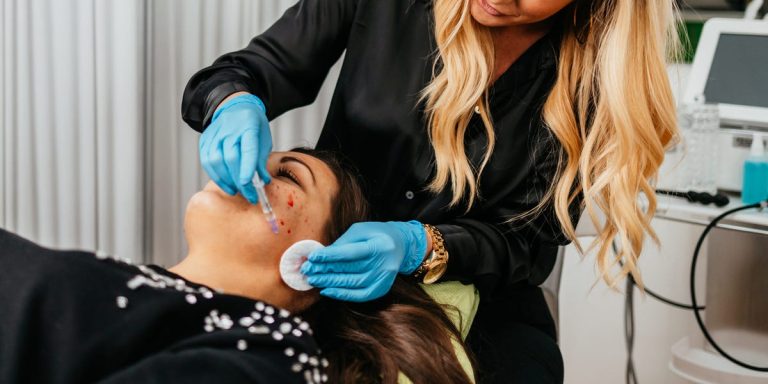Let’s start with the basics. “‘PRP’ refers to ‘platelet-rich plasma,’ which is a blood component that can be used to help with wound healing, hair loss, facial rejuvenation, and scarring,” explains the board-certified dermatologist based in New York. Marisa Garshick, MD. “When used in the form of a PRP facial, it is applied in conjunction with microneedling to facilitate its absorption into the skin.”
PRP—which is rich in growth factors—has been shown to stimulate healing, tissue regeneration and collagen production, says the New York-based board-certified dermatologist Pooja Rambhia, MD. “Over time and multiple treatment sessions, PRP facials can help rejuvenate the face, such as improving the appearance of fine lines, wrinkles, scars, and uneven skin tone,” says Dr. Rambhya. “PRP can also be introduced into the skin through direct injections or in conjunction with laser resurfacing.”
How does a PRP facial work?
If you’re nervous about needles and blood, PRP probably isn’t the procedure for you. It pretty much entails both. “PRP involves taking a person’s blood and then spinning it down using a centrifuge to get the platelet-rich portion,” explains Dr. Garshick. “From there it can then be used in conjunction with microneedling as microneedling creates small channels that PRP can penetrate to have an effect.” He adds that in some cases, platelet-rich plasma can be injected directly into “problem” areas such as fine lines and wrinkles.
What are the benefits of a PRP facial?
As noted, PRP facials can help treat a variety of cosmetic concerns, from wounds and hair loss to signs of aging. Dr. Garshick says PRP facials are especially beneficial for anyone looking to improve the appearance of fine lines and wrinkles, as well as other textural changes such as skin laxity. “By boosting collagen, PRP facials can also help improve areas of volume loss, such as under the eyes or nasolabial folds,” she adds.
To quickly recap, the benefits of a PRP facial include:
- Minimize fine lines and wrinkles
- Reducing the appearance of acne scars
- Improving overall skin texture
- Fading acne scars
- Acceleration of wound healing
- Filling in areas with volume loss
Are PRP facials safe?
The short answer is yes — as long as they are administered by trained experts. “PRP facials are safe when performed by board-certified dermatologists,” says Dr. Rambhya. That last part is key because WHERE performing the procedure is one of the most important things to consider: In April 2024, the CDC reported three cases of women who contracted HIV after PRP “vampire facial” at an unlicensed spa in Albuquerque, New Mexico, which was found to be engaging in unsafe infection control practices.
Although this was a rare case, these cases highlight the importance of going through this process — and let’s face it, Any medical procedure—by a trained professional in a medical-grade facility with appropriate infection control practices.
What are the side effects of PRP facials?
In general, the side effects of PRP facials are minimal and short-lived. “The most common side effects after a PRP facial include the expected redness, swelling that generally subsides within a few days, and mild bruising, which can take, on average, a week to resolve,” says Dr. Rambhya.
Risks, on the other hand, are usually due to improper infection control procedures or unlicensed professionals performing the procedure. “These include the risks of blood-borne infections such as HIV or hepatitis,” says Dr Rambhia. Additionally, Dr. Garshick says that scarring and hyperpigmentation are both risks, so be sure to visit a trained professional you trust to reduce the chances of these adverse effects.
Who Should Not Have Facial PRP?
As mentioned earlier, this would be anyone who cannot handle blood and/or needles. Additionally, Dr. Rambhia says people who should avoid PRP facials include people with platelet dysfunction conditions, blood cancers, low hemoglobin or platelet counts, active infections, and blood cancers. “In general, the associated use of blood thinners should also be avoided if possible, as this may increase the risk of bruising,” he adds.
Additionally, Dr. Garshick says that while PRP is considered safe for all skin tones and types, it’s still important for those with darker complexions to be cautious. “This is especially true if you have the treatment after being in the sun, as it can increase the risk of hyperpigmentation.”
How much does a PRP facial cost?
As with any skin care procedure, this can vary greatly depending on a variety of different factors. “The cost of PRP treatments can change significantly depending on a myriad of factors, including the specific application of the treatment, the clinic you visit, and even geographic location,” says Dr. Rambhia. “Therefore, it’s best to visit your local dermatologist for a thorough evaluation to see if you’re a good candidate for PRP and get a quote, although generally the cost can range from $500 to $2,000 per session.”

Kaleigh Fasanella is a beauty and wellness writer with a decade of experience contributing to digital media. Having a rare genetic skin condition, she is extremely passionate about skin care and spreading skin acceptance. When she’s not furiously typing on her laptop, you can find her binge-watching British crime dramas, trying out TikTok recipes, and singing (badly) in the shower. If you want you can follow her @kaleighfaz.


